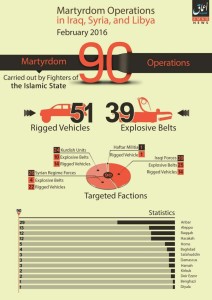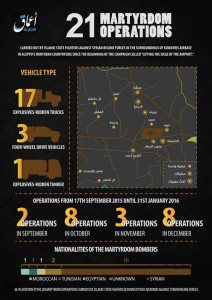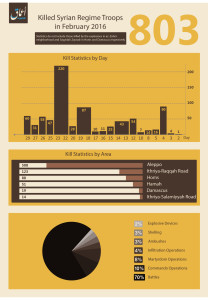The Syrian Army and its Iranian-backed allies have retaken the ancient city of Palmyra from the Islamic State. After several days of heavy fighting, Bashar al Assad’s regime claimed victory over the so-called caliphate’s fighters.
The Islamic State initially tried to deny that the Syrian government was making progress. On Mar. 24, the Amaq News Agency, which is one of the group’s propaganda outlets, released a video supposedly showing the jihadists in complete control of the city. Within days, however, Assad’s military was claiming victory.
The Islamic State captured Palmyra in May 2015. A few months later, in August 2015, the group also seized the nearby town of Qaryatain. But that town and others surrounding Palmyra are now reportedly being targeted by forces loyal to Assad and his partners. The Syrian regime hopes to follow up its success in Palmyra by pushing the Islamic State out of Qaryatain.
Even though Palmyra had been under the Islamic State’s control since last May, the area surrounding the city was contested in the months that followed.
According to the Syrian Observatory for Human Rights (SOHR), the two sides repeatedly clashed in the outlying areas throughout 2015. SOHR also reported on multiple occasions that Syrian warplanes had bombed locations inside the city. In August 2015, SOHR claimed that the Syrian government’s “helicopters dropped more than 10 barrel bombs on areas in the outskirts of Palmyra city and its vicinity.”
During the months it controlled Palmyra, the Islamic State destroyed and looted some of its historic sites. The jihadists also executed Khaled Asaad, a scholar in charge of the city’s antiquities.
Palmyra’s ruins were used as a backdrop for the Islamic State’s gruesome execution videos. In July 2015, the organization executed more than two dozen Syrian regime soldiers in an ancient amphitheater.

As the battle intensified over the course of the last week, the Islamic State attempted to thwart the Syrian regime’s advances by deploying its infamous suicide bombers. Abu Bakr al Baghdadi’s men claim to have killed dozens of Syrian soldiers, Hezbollah fighters and even several Russian soldiers during the fighting. While this slowed the progress made by Assad’s soldiers and the Shiite militiamen who fight alongside them, it wasn’t enough for the Sunni jihadists to carry the day.
It is not clear how many “martyrs” were used in Palmyra. However, the Islamic State’s media arm will likely include a count in its weekly Al Naba newsletter or in a monthly tally produced by Amaq, which regularly publish statistics summarizing the jihadists’ global suicide operations. For instance, Amaq’s infographic for February can be seen on the right.
According to Amaq, the Islamic State carried out 175 “martyrdom operations” in January and February. Fifty-five of these (or more than 31 percent) targeted Syrian regime forces.
Assad regime fights Islamic State in several areas of Syria
Bashar al Assad’s regime and the Islamic State have fought one another on several key battlefields over the past year.
In November 2015, the Syrian Army and its paramilitary allies ended the Islamic State’s siege of the Kweiris air base in Aleppo province. The “caliphate’s” jihadists held their ground surrounding Kweiris for nearly two years, cutting off the Assad loyalists who were defending the facility from reinforcements.
However, Russian air support changed the balance of power. Syrian and Iranian-backed ground forces broke through the jihadists’ lines, capturing villages surrounding Kweiris before freeing many of the soldiers who had been surrounded inside the base. According to the SOHR, the Syrian military fought alongside Hezbollah jihadists, Syria’s National Defense Forces (a collection of pro-Assad militias) and “Iranian fighters” as they made their way toward Kweiris. [See LWJ report, Assad regime, allies break Islamic State’s siege of air base in Aleppo.]

The Islamic State has continued to attack Assad’s forces near Kweiris air base in the months since. In February, Amaq released an infographic (seen on the right) claiming that Islamic State fighters carried out “21 martyrdom operations” in the area between Sept. 17, 2015 and Jan. 31, 2016. All of the suicide bombings used VBIEDs (vehicle-borne improvised explosive devices). Eleven of the 21 attacks took place in November and December 2015.
The two sides have battled each other elsewhere in Aleppo province as well. The Syrian regime’s major supply route in the province runs through the town of Khanaser. The Sunni jihadists launched an offensive in February as part of their attempt to close off the road. The fierce fighting that ensued continued into March.
The Islamic State initially cut off the Khanaser supply route, but the Syrian Army responded with a counteroffensive. Since late February, Syrian government forces, backed by Iranian-sponsored proxies and Russian air support, have repeatedly claimed progress in Khanaser and the neighboring areas in Aleppo province.
On Mar. 23, SANA (Assad’s propaganda arm) denied social media reports suggesting the road through Khanaser had been shuttered once again by the Islamic State. SANA claimed that the road had been “fully secured by the army” earlier in the month and that the traffic was now “normal.”
But the Islamic State continues to challenge Assad’s fighters near Khanaser. Earlier today, for example, Amaq reported that a “martyrdom operation” targeted “Syrian regime forces” who were “attempting to advance … east of Khanaser in the Aleppo countryside.” Indeed, the jihadists have targeted this vital artery since last year, periodically disrupting the Syrian regime’s ability to move supplies and forces along the road.

Given the ongoing battles along the key supply route running through Khanaser, it is unsurprising that Amaq claims that the Syrian regime lost more fighters in Aleppo in February than in any other province. For instance, Amaq produced an infographic (seen on the right) purportedly summarizing the total number of Syrian regime troops killed during the month of February. Nearly two-thirds (508 out of 803) of the claimed casualties occurred in the Aleppo province. The remaining 295 Syrian troops were supposedly killed by the Islamic State in five other areas.
Of course, it is impossible to verify the statistics published by Amaq. And it is not clear how the “news” agency could generate such precise figures for the regime’s casualties.
The Islamic State and Assad’s forces are at each other’s throats in the eastern city of Deir Ezzor as well. Yesterday, Amaq posted a video allegedly showing a Syrian soldier who defected to Baghdadi’s men in Deir Ezzor. Earlier this month, Amaq also claimed that the jihadists had gained ground in the southern part of Deir Ezzor. Multiple suicide bombers have been dispatched in recent days to strike regime forces in and around the city.
If Assad’s government can hold onto Palmyra, then it will be a significant victory against the Islamic State. Abu Bakr al Baghdadi’s proto-state faces significant opposition on several fronts, including from Assad, Shiite militias and Russia.








7 Comments
Is the USA a democracy? If yes, why is it not fighting ISIS effectively? Is Saudi Arabia a democracy? If No, why is the US, if a democracy it’s best friend.
–Nidhin Olikara
A democrat from the world’s biggest democracy India
RT is reporting that Americans were assisting the Russians and Syrians to re-take Palmyra. They even had a picture with some very Gringo-looking operator types. Nothing would make me prouder as an American Veteran than us joining hands with Putin to take out the Islamic State trash. We need him more than he needs us.
Assad has the City but lost eight generals in the attack and hundreds of vehicles. But once the outer ring collapsed IS retreated and didn’t fight street by street. The Airbase was also taken intact as well.
For those interested in how (un)peacefully it all began in Syria:
http://radioyaran.com/2016/03/29/syrias-revolution-what-we-did-not-want-to-see/
THE FIGHTING FOR NOT ONLY THE ANCIENT OF PALMYRA IF THE WHOLE COUNTRY OF THE THE SYRIAN ARAB REPUBLIC. WHO IS VICTORIOUS OF THIS BLOODY WAR.
A few months ago many news sources were calling Russia “ISIS’s airforce”. I think we can see this is not the case now!
Russia has run circles around the West in this whole thing. They’ve saved Assad from immediate annihilation, and now have withdrawn most of their forces to still get him to the negotiating table. What most people don’t realize, or don’t want to realize, is that by unconditionally calling for his removal we leave Syria to the mercy of Wahabi warlords. It would be a new Somalia with Jihadists in the Golan Heights. How is this a good idea, in any way?
Never was. Only winner here is Russia.
http://www.strategypage.com/qnd/syria/articles/20160330.aspx
Plus they’ve got the Iskander there now, along w the S-400. That’s a strong move.